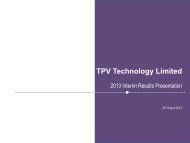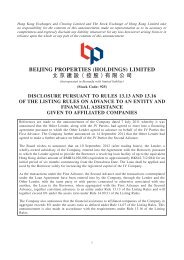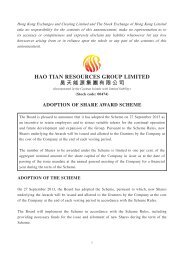Annual Report - QuamIR
Annual Report - QuamIR
Annual Report - QuamIR
You also want an ePaper? Increase the reach of your titles
YUMPU automatically turns print PDFs into web optimized ePapers that Google loves.
Notes to the Consolidated Financial Statements (Continued)<br />
<br />
3 Financial risk management (Continued)<br />
3.1 Financial risk factors (Continued)<br />
(b) Credit risk (Continued)<br />
To manage the credit risk associated with trade and other<br />
receivables and deposits paid for a property development<br />
project, the Group adopts risk control to assess the credit<br />
quality of the customers and debtors, taking into account<br />
their financial positions and past experience.<br />
3 <br />
3.1 <br />
(b) <br />
<br />
<br />
<br />
<br />
<br />
<br />
There is no concentration of credit risk with respect<br />
to trade receivables from third party customers as the<br />
customer bases are widely dispersed in different sectors<br />
and industries.<br />
<br />
<br />
<br />
In addition, the Group and the Company monitor the<br />
exposure to credit risk in respect of the financial assistance<br />
provided to subsidiaries, associated companies and jointly<br />
controlled entities through exercising control and significant<br />
influence over their financial and operating policy decisions<br />
and reviewing their financial positions on a regular basis.<br />
<br />
<br />
<br />
<br />
<br />
<br />
<br />
(c)<br />
Liquidity risk<br />
Liquidity risk is the risk that the Group is unable to meet its<br />
current obligations when they fall due. The Group measures<br />
and monitors its liquidity through the maintenance of<br />
prudent ratios regarding the liquidity structure of the overall<br />
assets, liabilities, loans and commitments of the Group.<br />
The Group also maintains a conservative level of liquid<br />
assets to ensure the availability of sufficient cash flows to<br />
meet any unexpected and material cash requirements in<br />
the course of ordinary business.<br />
(c)<br />
<br />
<br />
<br />
<br />
<br />
<br />
<br />
<br />
<br />
<br />
The table below analyses the Group’s and the Company’s<br />
<br />
contractual maturity for their financial liabilities. The<br />
<br />
amounts disclosed in the table have been drawn up with<br />
<br />
reference to the undiscounted cash flows of the financial<br />
<br />
liabilities based on the earliest date on which the Group<br />
<br />
and the Company can be required to pay.<br />
•<br />
111
















